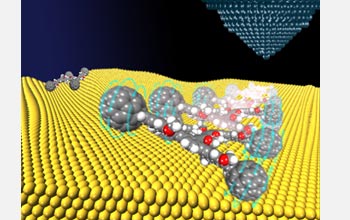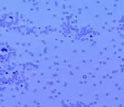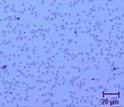|

Press Release 09-080
"Fantastic Voyage" Not So Far-fetched

Studies yield clues to powering nano-sized machines
April 23, 2009
View a video of real-time "predator-prey" behavior of silica spheres towards UV-illuminated silver chloride.
A new paper published in the May 2009 issue of the oldest continuously published magazine in the United States, Scientific American, asks readers to imagine producing vehicles so small they would be about the size of a molecule and powered by engines that run on sugar. To top it off, a penny would buy a million of them. The concept is nearly unthinkable, but it's exactly the kind of thing occupying National Science Foundation supported researchers at Penn State and Rice universities. For several years, Ayusman Sen, who heads Penn State's department of chemistry, and his colleague Thomas E. Mallouk, director of the Center for Nanoscale Science at Penn State, have investigated technologies that could realize these remarkable machines whose uses might include delivering medicine to specific tissue, accomplishing surgeries or communicating with the outside world from inside the human body. Though researchers consistently have improved ways to build nano-machines, the stumbling block has been finding a way to power them. Shrinking energy producers--internal combustion engines, electric motors or jet engines--below millimeter dimensions is not an easy task, but researchers may be closer to a fantastic solution. In the 1966 movie Fantastic Voyage, scientists shrink a submarine to microscopic size and inject it into the blood stream of a brilliant scientist, who has a blood clot forming in his brain. The nano-sized surgeons then set out to remove the blood clot. Today, researchers can steer nano-machines, use them to convey cargo, and guide them using electromagnetic forces or chemical interactions. All of this, they say, makes the world seen in Fantastic Voyage not so far-fetched.
-NSF-

Media Contacts
Bobbie Mixon, NSF (703) 292-8070 bmixon@nsf.gov
Program Contacts
Thomas P. Rieker, NSF (703) 292-4914 trieker@nsf.gov
Principal Investigators
Ayusman Sen, Penn State University (814) 863-2460 asen@psu.edu
Thomas E. Mallouk, Penn State University (814) 863-9637 tom@chem.psu.edu
Related Websites
How to Build Nanotech Motors - Scientific American: http://www.sciam.com/article.cfm?id=how-to-build-nanotech-motors
The Sen Group - Supporting Information: /news/longurl.cfm?id=159

The National Science Foundation (NSF) is an independent federal agency that supports fundamental research and education across all fields of science and engineering. In fiscal year (FY) 2009, its budget is $9.5 billion, which includes $3.0 billion provided through the American Recovery and Reinvestment Act. NSF funds reach all 50 states through grants to over 1,900 universities and institutions. Each year, NSF receives about 44,400 competitive requests for funding, and makes over 11,500 new funding awards. NSF also awards over $400 million in professional and service contracts yearly.
 Get News Updates by Email Get News Updates by Email
Useful NSF Web Sites:
NSF Home Page: http://www.nsf.gov
NSF News: http://www.nsf.gov/news/
For the News Media: http://www.nsf.gov/news/newsroom.jsp
Science and Engineering Statistics: http://www.nsf.gov/statistics/
Awards Searches: http://www.nsf.gov/awardsearch/
| 





